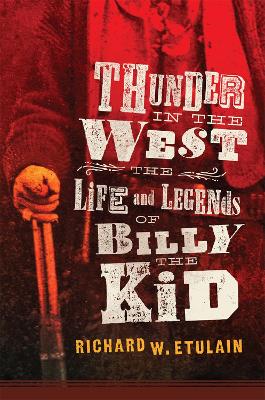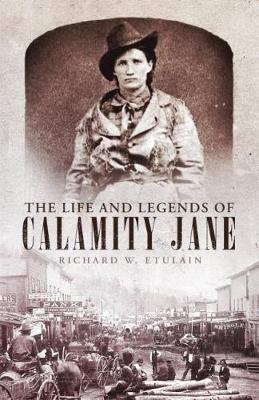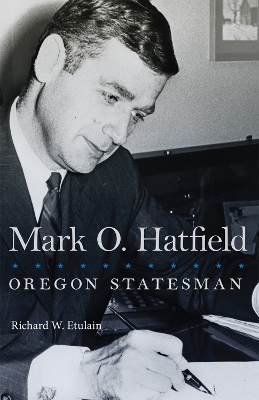The Oklahoma Western Biographies
3 total works
Even before he was shot and killed in 1881, Billy the Kid's charisma and murderous career were generating stories that belied his brief life - and that only multiplied, growing to legendary proportions after his death at age twenty-one. In Thunder in the West, Richard W. Etulain takes the true measure of Billy, the man and the legend, and presents the clearest picture yet of his life and his ever-shifting place and presence in the cultural landscape of the Old West.
Billy the Kid - born Henry McCarty in 1859, and also known as William H. Bonney - emerges from these pages in all his complexity, at once a gentleman and gregarious companion, and a thief and violent murderer. Tapping new depths of research, Etulain traces Billy's short life from his mysterious origins in the East through his wanderings in New Mexico, Arizona, and Texas. As we move from his peripatetic early years through the wild West to his fatal involvement in the Lincoln County Wars, we see the impressionable boy give way to the conflicted young man and, finally, to the opportunistic and often amoral outlaw who was out for himself, for revenge, and for whatever he could steal along the way.
Against this deftly drawn portrait, Etulain considers the stories and myths spawned by Billy's life and death. Beginning with the dime novels featuring Billy the Kid, even during his lifetime, and ranging across the myriad newspaper accounts, novels, and movies that alternately celebrated his outlaw life and condemned his exploits, Etulain offers a uniquely informed view of the changing interpretations that have shaped and reshaped the reputation of this enduring icon of the Old West. In his portrayal, Billy the Kid lives on, not as a cut-throat desperado or a young charmer but as both - hero and villain, myth and man, fully realized in this twenty-first-century interpretation.
Billy the Kid - born Henry McCarty in 1859, and also known as William H. Bonney - emerges from these pages in all his complexity, at once a gentleman and gregarious companion, and a thief and violent murderer. Tapping new depths of research, Etulain traces Billy's short life from his mysterious origins in the East through his wanderings in New Mexico, Arizona, and Texas. As we move from his peripatetic early years through the wild West to his fatal involvement in the Lincoln County Wars, we see the impressionable boy give way to the conflicted young man and, finally, to the opportunistic and often amoral outlaw who was out for himself, for revenge, and for whatever he could steal along the way.
Against this deftly drawn portrait, Etulain considers the stories and myths spawned by Billy's life and death. Beginning with the dime novels featuring Billy the Kid, even during his lifetime, and ranging across the myriad newspaper accounts, novels, and movies that alternately celebrated his outlaw life and condemned his exploits, Etulain offers a uniquely informed view of the changing interpretations that have shaped and reshaped the reputation of this enduring icon of the Old West. In his portrayal, Billy the Kid lives on, not as a cut-throat desperado or a young charmer but as both - hero and villain, myth and man, fully realized in this twenty-first-century interpretation.
Everyone knows the name Calamity Jane. Scores of dime novels and movie and TV Westerns have portrayed this original Wild West woman as an adventuresome, gun-toting hellion. Although Calamity Jane has probably been written about more than any other woman of the nineteenth-century American West, fiction and legend have largely obscured the facts of her life. This lively, concise, and exhaustively researched biography traces the real person from the Missouri farm where she was born in 1856 through the development of her notorious persona as a Wild West heroine.
Before Calamity Jane became a legend, she was Martha Canary, orphaned when she was only eleven years old. From a young age she traveled fearlessly, worked with men, smoked, chewed tobacco, and drank. By the time she arrived in the boomtown of Deadwood, South Dakota, in 1876, she had become Calamity Jane, and the real Martha Canary had disappeared under a landslide of purple prose.
Calamity became a hostess and dancer in Deadwood's saloons and theaters. She imbibed heavily, and she might have been a prostitute, but she had other qualities, as well, including those of an angel of mercy who ministered to the sick and the down-and-out. Journalists and dime novelists couldn't get enough of either version, nor, in the following century, could filmmakers.
Sorting through the stories, veteran western historian Richard W. Etulain's account begins with a biography that offers new information on Calamity's several ""husbands"" (including one she legally married), her two children, and a woman who claimed to be the daughter of Wild Bill Hickok and Calamity, a story Etulain discredits. In the second half of the book, Etulain traces the stories that have shaped Calamity Jane's reputation. Some Calamity portraits, he says, suggest that she aspired to a quiet life with a husband and family. As the 2004-2006 HBO series Deadwood makes clear, well more than a century after her first appearance as a heroine in the Deadwood Dick dime novels, Calamity Jane lives on - raunchy, unabashed, contradictory, and ambiguous as ever.
Before Calamity Jane became a legend, she was Martha Canary, orphaned when she was only eleven years old. From a young age she traveled fearlessly, worked with men, smoked, chewed tobacco, and drank. By the time she arrived in the boomtown of Deadwood, South Dakota, in 1876, she had become Calamity Jane, and the real Martha Canary had disappeared under a landslide of purple prose.
Calamity became a hostess and dancer in Deadwood's saloons and theaters. She imbibed heavily, and she might have been a prostitute, but she had other qualities, as well, including those of an angel of mercy who ministered to the sick and the down-and-out. Journalists and dime novelists couldn't get enough of either version, nor, in the following century, could filmmakers.
Sorting through the stories, veteran western historian Richard W. Etulain's account begins with a biography that offers new information on Calamity's several ""husbands"" (including one she legally married), her two children, and a woman who claimed to be the daughter of Wild Bill Hickok and Calamity, a story Etulain discredits. In the second half of the book, Etulain traces the stories that have shaped Calamity Jane's reputation. Some Calamity portraits, he says, suggest that she aspired to a quiet life with a husband and family. As the 2004-2006 HBO series Deadwood makes clear, well more than a century after her first appearance as a heroine in the Deadwood Dick dime novels, Calamity Jane lives on - raunchy, unabashed, contradictory, and ambiguous as ever.
In a career in public office spanning five decades, Mark Odom Hatfield (1922-2011) never lost an election. First elected to the Oregon House of Representatives in 1950, he retired from political office in 1997 after serving as Oregon state senator, secretary of state, and governor and as United States senator for five terms. He was arguably the state's most important politician, but his brand of liberal-to-moderate Republicanism has long since vanished from the political stage. Mark O. Hatfield: Oregon Statesman tells Hatfield's story-as an Oregonian, a politician, and a man of practical vision, deep convictions, and far-reaching consequence in the civic life of the state and the nation.
A lifelong evangelical Christian and Republican-per his mother's fondest wishes-and politically inclined from a young age, Hatfield came to office after studying and teaching political science and observing firsthand the ravages of war in the Pacific and the cruelty of segregation at home. Historian Richard W. Etulain portrays Hatfield as an energetic young Republican legislator in a state becoming increasingly Democratic. He pushed civil rights legislation, supported laborers as well as business interests, and struck a balance that would align him with moderates even as the party's conservative wing became ascendant. Elected in 1958 as Oregon's youngest-ever governor, Hatfield went on to become the first in the twentieth century to hold that office for two terms, using his tenure to streamline the state's executive branch and promote Oregon as a prime destination for business and tourism-efforts that quickly earned him a place on the national stage. Etulain focuses on Hatfield as a force in Oregon state politics but also examines his long tenure as a U.S. senator, garnering attention early for his stance against the Vietnam War and later for his antinuclear position.
The private life, the public figure, the man of faith and family, of an older West and the new: this biography, while compact, captures Mark Hatfield in full, as a major western politician of the twentieth century.
A lifelong evangelical Christian and Republican-per his mother's fondest wishes-and politically inclined from a young age, Hatfield came to office after studying and teaching political science and observing firsthand the ravages of war in the Pacific and the cruelty of segregation at home. Historian Richard W. Etulain portrays Hatfield as an energetic young Republican legislator in a state becoming increasingly Democratic. He pushed civil rights legislation, supported laborers as well as business interests, and struck a balance that would align him with moderates even as the party's conservative wing became ascendant. Elected in 1958 as Oregon's youngest-ever governor, Hatfield went on to become the first in the twentieth century to hold that office for two terms, using his tenure to streamline the state's executive branch and promote Oregon as a prime destination for business and tourism-efforts that quickly earned him a place on the national stage. Etulain focuses on Hatfield as a force in Oregon state politics but also examines his long tenure as a U.S. senator, garnering attention early for his stance against the Vietnam War and later for his antinuclear position.
The private life, the public figure, the man of faith and family, of an older West and the new: this biography, while compact, captures Mark Hatfield in full, as a major western politician of the twentieth century.


